Many people wonder if their whey protein powder is made from worms. It’s a common myth that needs to be cleared up.
In this blog, we’ll uncover the truth about whey protein, debunking this rumor and explaining what’s really inside your protein powder.
Let’s dive into the facts!
Key Takeaways:
- Whey Protein Types: Whey Protein Isolate (WPI) offers the highest protein content (90%+), ideal for muscle gain and low-lactose diets, while Whey Protein Concentrate (WPC) has 70-80% protein, suitable for general fitness.
- Taste & Mixability: Choose protein powders with natural flavoring and good mixability. Look for smooth texture without lumps or grittiness.
- Lactose Considerations: For lactose-intolerant individuals, WPI or hydrolyzed whey are the best options as they contain minimal lactose compared to WPC.
What is Whey Protein Powder? Breaking Down the Basics
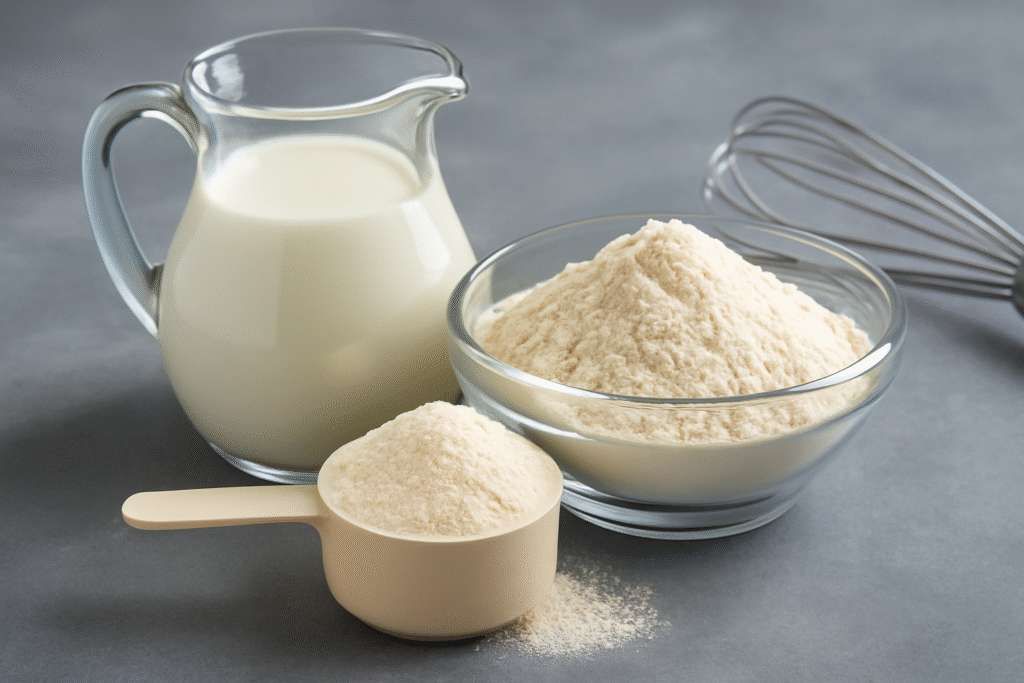
Whey protein is a high-quality protein sourced from milk. It’s a byproduct of the cheese-making process, where liquid whey separates from the curd (solid part of milk). This liquid whey is then processed to create the protein powder we consume.
The Extraction Process:
Step 1: Milk is Curled
Milk is combined with an enzyme to separate the solid curds (used for cheese) from the liquid whey.
Step 2: Whey Is Filtered and Processed
After the whey is collected, it’s filtered and purified to remove excess fats and carbohydrates. The resulting liquid contains the valuable protein.
Step 3: Drying
The purified whey is then spray-dried into a powder form. This creates the different types of whey protein powders you see on the market:
Whey Protein Concentrate (WPC)
Contains around 70-80% protein and retains some fat and carbs. It’s great for those who want a more natural, nutrient-rich option.
Whey Protein Isolate (WPI)
Is 90% protein or more with minimal fats and carbs. It’s ideal for people looking to maximize protein intake without added calories.
Whey Protein Hydrolysate (WPH)
It’s pre-digested for faster absorption. This makes it suitable for athletes who need quick muscle recovery.
Actionable Step: When to Use Each Type of Whey Protein
- WPC: Use this if you want a balanced option that’s great for overall health and fitness.
- WPI: Choose this if you’re looking for a low-carb, low-fat option, especially for cutting.
- WPH: This is best after intense workouts for faster muscle repair and recovery.
Whey protein is not just for bodybuilders. It’s a versatile, convenient source of high-quality protein that fits well in many healthy diets.
Common Questions About Whey Protein
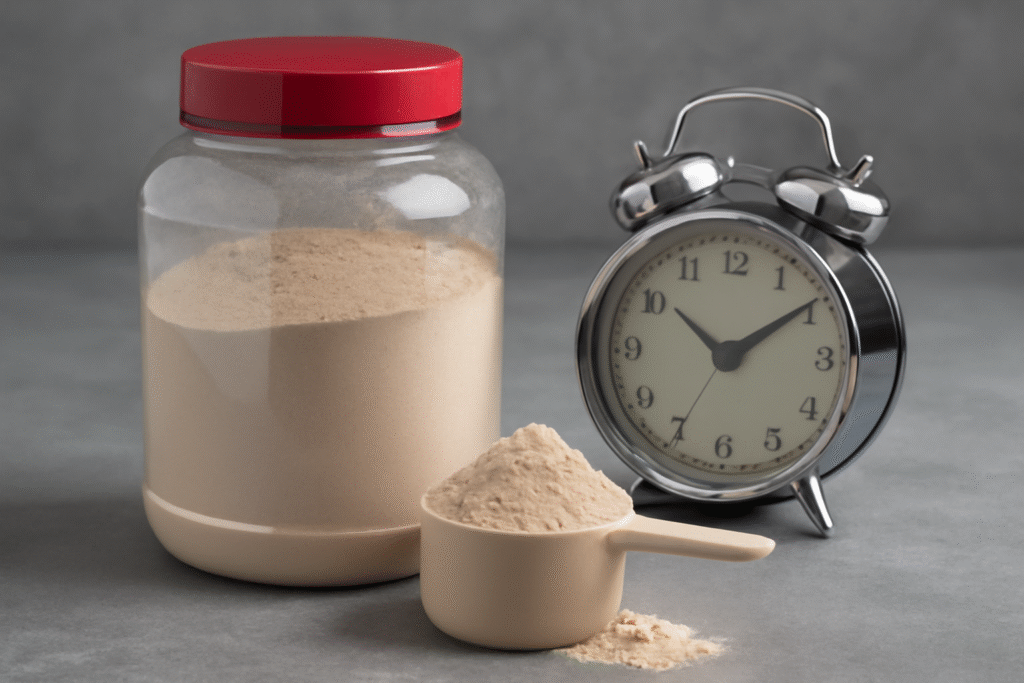
Does Whey Protein Contain Caffeine?
Most whey protein powders do not contain caffeine. However, some brands add caffeine for energy boosts. Always check the label for ingredients.
How Much Protein is in One Scoop of Whey?
One scoop of whey protein typically provides 20-30 grams of protein, depending on the type (concentrate, isolate, or hydrolysate).
Does Whey Protein Isolate Have Lactose?
Whey protein isolate has very little lactose, making it a better choice for those with lactose sensitivity. However, some trace amounts may remain.
Actionable Step:
For lactose-free options, choose high-quality whey protein isolate or hydrolysate. Popular brands like Gold Standard Whey Isolate are ideal for those avoiding lactose or caffeine.
“Some brands add caffeine for energy boosts, but most whey protein powders don’t contain caffeine” — Reddit user feedback.
What’s Inside Your Whey Protein: Ingredients Breakdown
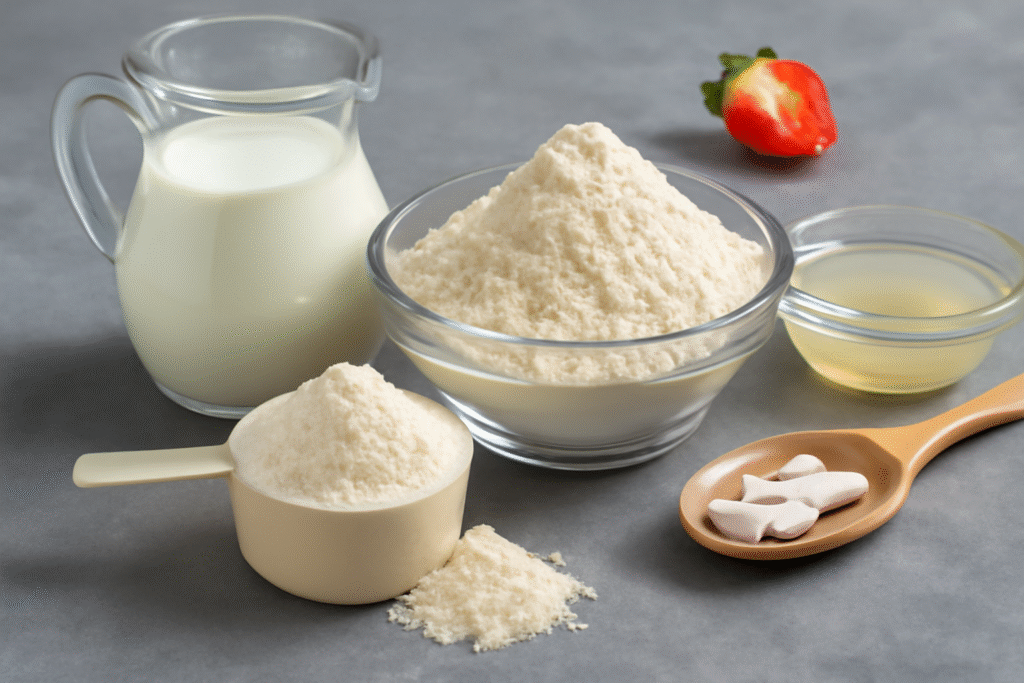
Whey protein is a popular supplement that many athletes and fitness enthusiasts use to support their muscle growth and recovery. But what exactly is inside your whey protein powder?
Let’s break it down so you can make a better-informed choice.
1. Core Ingredients in Whey Protein Powder
- Milk: Whey protein is a byproduct of milk. During the cheese-making process, milk is separated into curds and whey. The liquid whey is then processed to make protein powder.
- Whey Protein Concentrate (WPC): This is the most common form of whey protein. It contains 70-80% protein with a balance of fats and carbs. It’s often used in basic protein powders due to its affordability.
- Whey Protein Isolate (WPI): A more refined version, WPI has over 90% protein content and is almost free of fats and carbs. It’s ideal for those seeking a high-protein, low-calorie option.
- Sweeteners (like Stevia): Many whey protein powders contain sweeteners like stevia or sucralose to improve taste. While stevia is natural and safe, some people may prefer to avoid artificial sweeteners for personal or health reasons.
- Flavorings: Added to enhance taste, flavors such as vanilla, chocolate, or strawberry are commonly used. Most of these are artificial, but there are natural alternatives in higher-end products.
- Thickeners: Some protein powders contain thickeners like xanthan gum or guar gum. These ingredients help create a smooth texture, but they can cause digestive discomfort for some people.
2. Additives and Their Impact on Health
Not all additives are harmful, but it’s important to be aware of what’s in your protein powder.
- Artificial Sweeteners:
While stevia is natural, other sweeteners like sucralose can affect your gut health. Over time, artificial sweeteners may disrupt your gut microbiome, which plays a key role in overall health. - Thickeners and Fillers:
Additives like thickeners are typically harmless, but they may cause bloating or discomfort, especially for people with sensitive stomachs.
3. Effect on Skin Conditions: Whey Protein and Acne
Whey protein can have a mixed effect on the skin. For some people, it helps build muscle and improve overall health, but for others, it can lead to breakouts. Here’s why:
- Potential Causes of Acne:
Whey protein can increase insulin levels and raise the secretion of insulin-like growth factor (IGF-1), both of which have been linked to acne. If you’re prone to acne, this might cause breakouts. - User Insight:
One Quora user shared, “I noticed my skin breaking out after using whey protein concentrate. Switching to whey isolate helped reduce the breakouts.” This suggests that the type of whey protein you choose could make a difference.
4. Actionable Step: What to Do if You Have Sensitive Skin or Acne
If you’re concerned about whey protein affecting your skin, there are a few things you can try:
- Opt for Whey Protein Isolate (WPI):
Whey protein isolate contains fewer additives and lactose, making it a better option for those with sensitive skin. - Consider Plant-Based Protein Powders:
If you’re worried about whey’s impact on your skin, try plant-based protein powders like pea protein or hemp protein. These options are gentle on the digestive system and less likely to cause skin reactions. - Check the Ingredient List:
Always read the ingredient list for any artificial additives or sweeteners that could trigger inflammation or acne.
The Effect of Whey Protein on Skin and Hormones
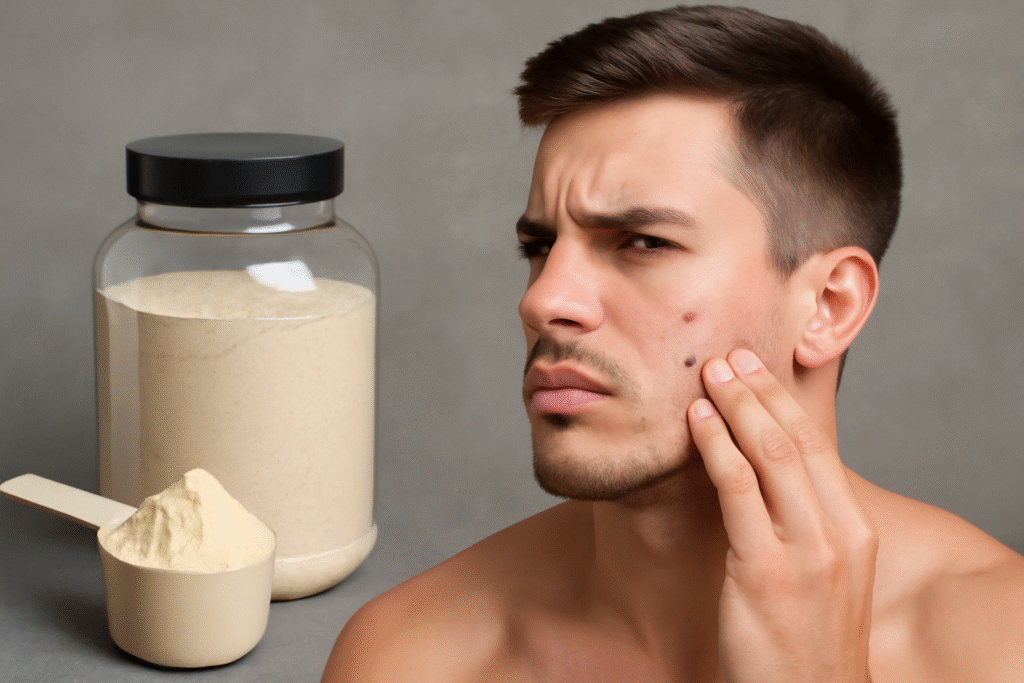
As a dietitian and fitness doctor with over 10 years of experience, I’ve seen both the benefits and side effects of whey protein. It’s a go-to supplement for muscle growth and recovery, but how does it affect your skin and hormones? Let’s dive into the science.
1. Whey Protein and Acne: What’s the Connection?
Whey protein can affect skin, particularly acne. Some research suggests whey protein could increase insulin levels in the body. Elevated insulin can lead to increased oil production in the skin, which can clog pores and cause acne breakouts.
- Why It Happens:
Whey protein triggers a rise in insulin-like growth factor (IGF-1), a hormone that promotes cell growth. IGF-1 can also stimulate oil glands, contributing to acne flare-ups. - Real User Insight:
One Reddit user shared, “I noticed a few more breakouts after taking whey, but switching to isolate helped.” This shows that whey protein may affect people differently. For some, it may worsen acne, while others may not see any skin issues. - Actionable Step:
If you’re prone to acne, consider switching to whey protein isolate (WPI) or hydrolyzed whey. These types have fewer additives and lactose, which might reduce skin irritation.
2. Whey Protein and Hormones: How It Impacts Your Body
Whey protein can influence hormone levels, which in turn can affect your skin and overall health. Here’s how:
- Testosterone:
Some studies show that whey protein may slightly increase testosterone levels in men. Elevated testosterone can lead to increased oil production in the skin, contributing to acne, especially in those already prone to hormonal acne. - IGF-1 and Growth Hormones:
Whey protein boosts IGF-1, which plays a role in muscle recovery. However, high IGF-1 levels may also promote oil production and acne development. For people with hormone-sensitive skin, this could mean more breakouts. - Real-World Example:
Many athletes and bodybuilders use whey to enhance muscle growth. However, some also report skin flare-ups due to changes in hormone levels from increased IGF-1.
3. Actionable Steps for Healthy Skin While Using Whey Protein
If you’re concerned about how whey protein may impact your skin, try these steps to minimize any side effects:
- Opt for Whey Protein Isolate (WPI):
WPI has fewer carbs, fats, and lactose than whey concentrate. It’s gentler on your digestive system and may cause fewer skin issues. - Switch to Hydrolyzed Whey:
This form of whey is broken down into smaller peptides for faster absorption. It’s ideal for people with sensitive skin or those worried about hormonal acne. - Monitor Hormonal Changes:
Pay attention to your body. If you notice more acne or skin irritation after adding whey to your diet, adjust your protein intake or switch to a plant-based option.
How Much Protein is in One Scoop of Whey?
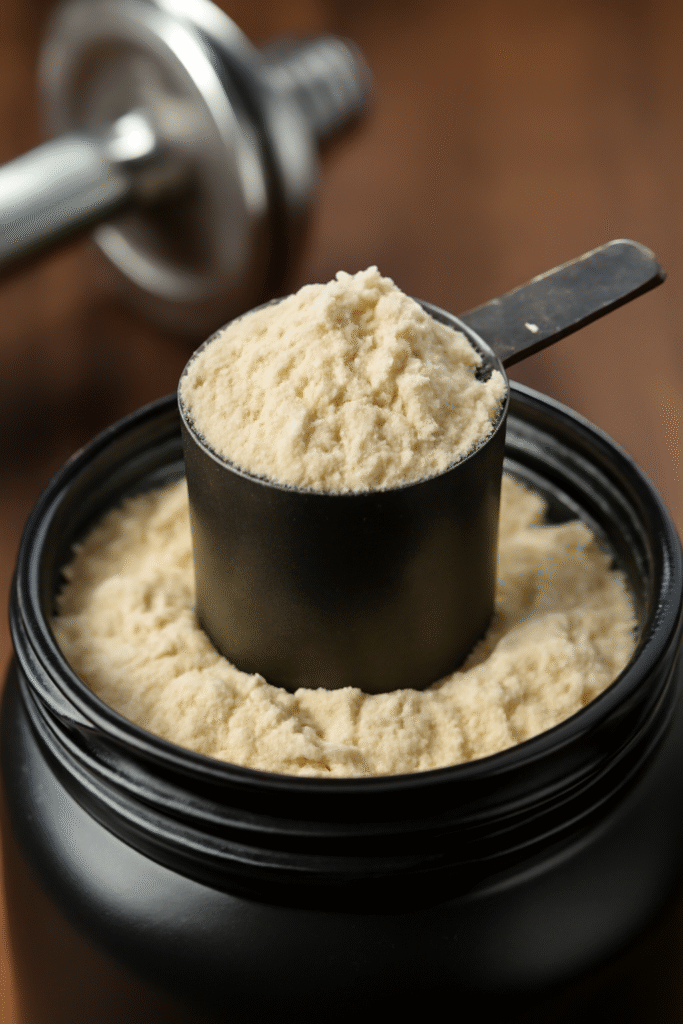
Whey protein is a powerful supplement used by athletes, fitness enthusiasts, and anyone looking to boost their protein intake. But how much protein does one scoop of whey protein powder actually contain?
1. The Protein Content in One Scoop of Whey Protein
The amount of protein in one scoop of whey protein powder can vary depending on the brand and type of whey. On average, you’ll find that one scoop of whey protein contains 20-30 grams of protein.
- Whey Protein Concentrate (WPC):
Contains about 20-25 grams of protein per scoop. It also retains some fat and carbs, making it a good option for those who want a more natural product. - Whey Protein Isolate (WPI):
Contains around 25-30 grams of protein per scoop. This type is more processed, with less fat and carbs, making it ideal for those looking to maximize protein intake while minimizing extra calories. - Hydrolyzed Whey Protein:
Similar to isolate, but with the protein broken down into smaller peptides for faster digestion. It typically offers 25-30 grams of protein per scoop, ideal for those who need rapid muscle recovery after intense workouts.
2. Impact of Protein Serving Sizes on Fitness and Muscle Recovery
Protein serves as the building block for muscles. Consuming the right amount is essential for muscle repair and growth, especially after strenuous workouts. Understanding how much protein you need based on your activity level and fitness goals can help maximize your results.
- For General Fitness:
If you’re just trying to stay fit and maintain muscle, 1.2–1.6 grams of protein per kilogram of body weight is recommended daily. If you’re consuming 20-30g of protein per scoop, you can easily meet this goal by having a protein shake once or twice a day. - For Muscle Building:
If you’re looking to gain muscle mass, aim for 1.6–2.2 grams of protein per kilogram of body weight. This might mean having multiple scoops of whey protein throughout the day to ensure you’re getting enough to support muscle growth and recovery. - For Weight Loss:
Protein helps with satiety and preserves lean muscle mass during weight loss. You might aim for 1.6–2.0 grams of protein per kilogram of body weight. A scoop of whey protein, combined with a balanced diet, can keep you feeling full and support fat loss while maintaining muscle.
3. Actionable Step: How to Calculate Your Protein Needs
To ensure you’re getting the right amount of protein to meet your fitness goals, here’s a simple formula:
Step 1: Find your body weight in kilograms. (If you’re in pounds, divide your weight by 2.2 to get kilograms.)
Step 2: Multiply your body weight by the recommended protein intake for your goal:
- For general fitness: 1.2–1.6 grams per kilogram
- For muscle building: 1.6–2.2 grams per kilogram
- For weight loss: 1.6–2.0 grams per kilogram
Step 3: Divide your total daily protein goal by the number of meals or shakes you plan to have per day to determine how much protein you need per serving.
Example: If your daily protein target is 120g and you have 3 meals with 1 protein shake, each meal would need 30g of protein, and your shake would need 30g of protein as well.
Example Calculation
Let’s say you weigh 70kg (about 154lbs) and your goal is muscle gain. You’ll aim for around 1.8 grams of protein per kilogram of body weight. So, your target protein intake for the day would be:
70kg x 1.8g = 126g of protein daily.
If you plan on having two protein shakes per day, each shake should have about 30-35 grams of protein.
Whey Protein Isolate vs Concentrate: Which is Right for You?
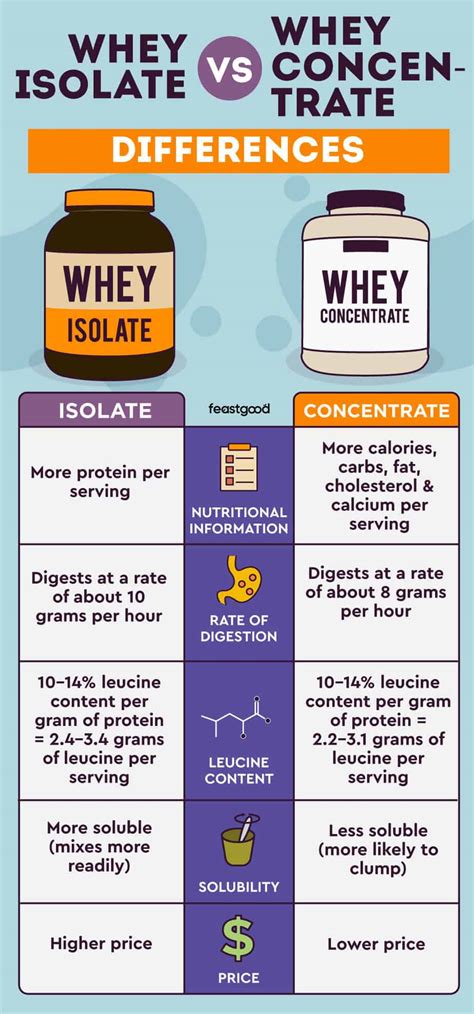
Whey protein is a high-quality protein derived from milk, commonly used to support muscle growth and recovery. Two primary forms of whey protein are available: Whey Protein Isolate (WPI) and Whey Protein Concentrate (WPC).
While both serve as excellent protein sources, they differ in processing, nutritional content, and suitability for various dietary needs.
| Feature | Whey Protein Isolate (WPI) | Whey Protein Concentrate (WPC) |
|---|---|---|
| Protein Content | ≥90% by weight | 70–80% by weight |
| Lactose Content | <1% (minimal) | 2–5% (moderate) |
| Fat Content | Low (minimal) | Moderate |
| Carbohydrates | Low (minimal) | Moderate |
| Calories per Scoop | Approximately 100–120 kcal | Approximately 120–150 kcal |
| Digestibility | Fast absorption | Moderate absorption |
| Taste & Texture | Lighter, less creamy | Creamier, richer flavor |
| Cost | Higher (due to additional processing) | Lower (less processing) |
| Best For | Lactose-intolerant individuals, low-carb diets, post-workout recovery | General supplementation, those seeking a balanced nutrient profile |
Understanding the Differences
1. Protein Content
- Whey Protein Isolate (WPI): Undergoes extensive filtration, resulting in a higher protein concentration of at least 90% by weight.
- Whey Protein Concentrate (WPC): Less processed, containing 70–80% protein by weight, with the remainder comprising fats, carbohydrates, and lactose.
2. Lactose and Fat Levels
- WPI: The additional processing removes most of the lactose and fat, making it suitable for those with lactose intolerance.
- WPC: Retains more lactose and fat, which may cause digestive discomfort in individuals with lactose sensitivity.
3. Caloric Content
- WPI: Lower in calories due to reduced fat and carbohydrate content, beneficial for those monitoring caloric intake.
- WPC: Higher in calories, providing additional nutrients from fats and carbohydrates.
4. Digestibility and Absorption
- WPI: Fast-digesting, making it ideal for post-workout recovery to quickly supply amino acids to muscles.
- WPC: Digests at a moderate rate, suitable for general supplementation throughout the day.
5. Taste and Texture
- WPI: Generally lighter in taste and texture, with less creaminess.
- WPC: Offers a creamier texture and richer flavor due to higher fat content.
6. Cost
- WPI: More expensive due to the additional processing required.
- WPC: More affordable, making it a budget-friendly option for those seeking protein supplementation.
Choosing the Right Whey Protein for Your Needs
Opt for WPI if:
- You are lactose intolerant or have dairy sensitivities.
- You are following a low-carb or low-fat diet.
- You require a fast-digesting protein source for post-workout recovery.
Opt for WPC if:
- You are looking for a cost-effective protein supplement.
- You do not have lactose intolerance or dairy sensitivities.
- You prefer a creamier texture and richer taste in your protein shakes.
Does Whey Protein Contain Lactose?
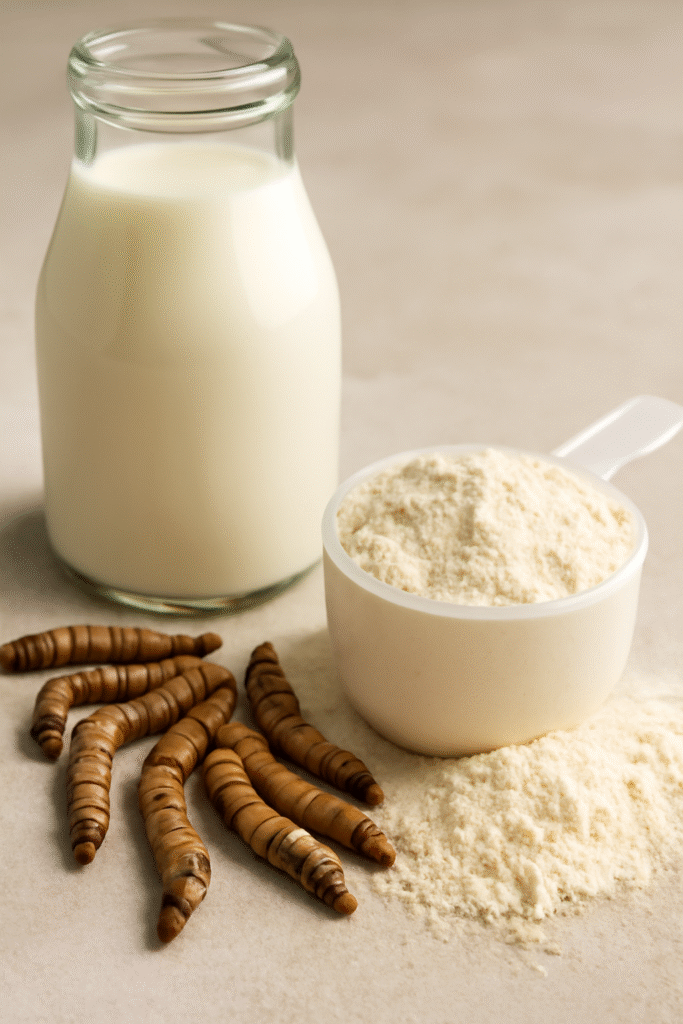
Whey protein is a popular supplement among fitness enthusiasts, but if you’re lactose intolerant, you might wonder: Does whey protein contain lactose? Let’s break it down.
1. What Is Lactose?
Lactose is a natural sugar found in milk. It’s what makes dairy products sweet and gives them their creamy texture. When you consume dairy, your body breaks down lactose into two simpler sugars, glucose and galactose, using an enzyme called lactase. However, some people don’t produce enough lactase, which leads to lactose intolerance—a condition that can cause bloating, gas, and stomach discomfort.
2. Does Whey Protein Have Lactose in It?
Yes, whey protein contains lactose, but the amount varies depending on the type of whey protein. Here’s the breakdown:
- Whey Protein Concentrate (WPC):
WPC contains moderate levels of lactose. It typically has about 2-5% lactose by weight. This means if you’re mildly lactose intolerant, you might tolerate WPC better than other dairy products. - Whey Protein Isolate (WPI):
WPI undergoes additional processing to remove most of the fats, carbs, and lactose. It contains less than 1% lactose, making it a better option for people with lactose intolerance. Most people with lactose sensitivity can digest WPI without issues. - Hydrolyzed Whey Protein:
Hydrolyzed whey is pre-digested for faster absorption, and it contains very little lactose, similar to whey protein isolate. This makes it a great option for those who have lactose intolerance and need a quick-absorbing protein after workouts.
3. Lactose-Free Whey Protein: What Are the Alternatives?
If you’re lactose intolerant, here are some options:
- Whey Protein Isolate (WPI):
Choose WPI if you’re sensitive to lactose. It’s processed to remove nearly all lactose while retaining a high protein content. It’s a great option for faster recovery after workouts. - Hydrolyzed Whey Protein:
This type of whey protein is broken down into smaller peptides, making it easier to digest and low in lactose. It’s perfect for anyone who experiences digestive discomfort with regular whey. - Plant-Based Protein:
If you’re highly sensitive to dairy or prefer a vegan option, plant-based proteins (like pea, hemp, or brown rice protein) are an excellent alternative. These are naturally lactose-free and provide a solid protein source without any dairy.
4. Actionable Step: Choose the Right Whey for You
If you’re worried about lactose, here’s what you can do:
- Opt for Whey Protein Isolate or Hydrolyzed Whey:
These are your best options for a high-protein, low-lactose supplement. - Test and Monitor Your Body’s Response:
If you’re unsure about your tolerance to lactose, start with a small serving of WPI or hydrolyzed whey and see how your body reacts. - Consider Plant-Based Protein if You’re Highly Sensitive:
If whey still causes issues, plant-based proteins are an effective alternative.
The Pros and Cons of Whey Protein Powder
Whey protein is widely used for muscle growth and recovery. Let’s take a look at the benefits and potential downsides.
Pros of Whey Protein:
- Quick Absorption:
Whey protein is digested quickly, making it great for post-workout recovery. - Muscle Building and Repair:
It provides all the essential amino acids your muscles need to grow and repair. - Convenient:
It’s a fast, portable, and high-quality protein source, especially for busy people.
Cons of Whey Protein:
- Digestive Discomfort:
Some people, especially those who are lactose intolerant, may experience bloating or gas. - Acne:
Whey protein can sometimes trigger acne in people sensitive to dairy. - Ethical Concerns:
As an animal-based protein, whey might not be suitable for those following vegan or plant-based diets.
Actionable Step:
If you’re worried about side effects like acne or digestive issues, consider trying plant-based proteins like pea or hemp protein, which are gentler on the stomach and skin.
How to Choose the Best Whey Protein for You
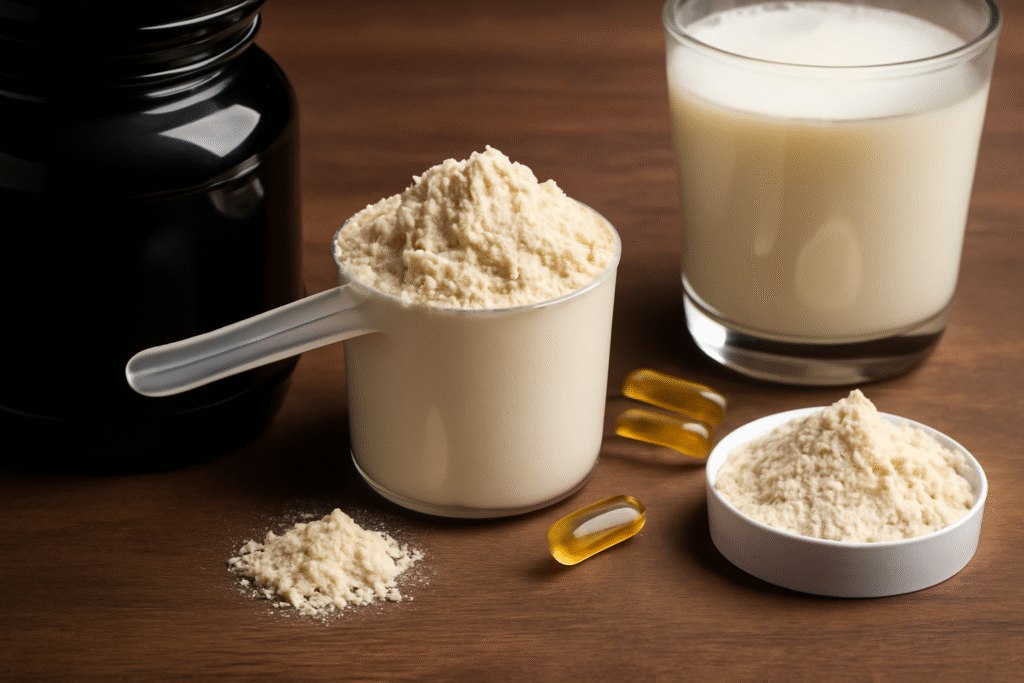
Selecting the right whey protein powder depends on your goals, taste preferences, and dietary needs. Here’s how you can make an informed choice.
1. Consider Your Goals
- Muscle Gain:
If you’re focused on muscle growth, opt for whey protein isolate (WPI). It has a higher protein content and fewer carbs and fats.
Example: Gold Standard Whey provides 24g of protein per scoop, ideal for muscle repair and growth. - Weight Loss or Leaning Out:
Choose whey protein isolate or hydrolyzed whey. They are low in calories and carbs, making them ideal for fat loss while preserving muscle. - General Fitness:
Whey Protein Concentrate (WPC) is great for everyday use. It provides a balance of protein, fats, and carbs, perfect for overall health and maintenance.
2. Taste and Mixability
- Taste matters. If you’re going to be consuming whey protein regularly, make sure you enjoy the flavor.
Tip: Look for natural flavoring and avoid added sugars or artificial sweeteners if you’re sensitive to them. - Check for good mixability. Some protein powders leave lumps or a gritty texture, while others dissolve smoothly in water or milk.
3. Ingredient Transparency
- Always check the ingredient list. High-quality protein powders should list the source of protein, like whey protein concentrate or whey protein isolate, and avoid fillers, artificial sweeteners, or unnecessary additives.
- User Insight:
One user on Quora shared, “I switched to [Brand] whey protein because it had fewer additives and helped with my stomach issues.” This highlights how ingredient transparency can improve your experience.
4. Lactose Content
- If you’re lactose intolerant, whey protein isolate (WPI) or hydrolyzed whey is your best choice, as they contain minimal lactose.
- WPC has more lactose, so it might cause digestive discomfort for those sensitive to it.
5. Price vs. Quality
- WPI and hydrolyzed whey tend to be more expensive due to additional processing, but they are purer and faster-digesting.
- WPC is more affordable but contains more carbs and fats. If you’re not concerned with those, it’s a budget-friendly option for a quality protein.
Comparison Table: Top Whey Protein Powders
| Protein Type | Protein Content | Lactose | Price | Best For |
|---|---|---|---|---|
| Whey Protein Isolate | 90%+ | <1% | Higher | Muscle gain, lactose-intolerant users |
| Whey Protein Concentrate | 70-80% | Moderate | Lower | General fitness, budget-conscious |
| Hydrolyzed Whey | 90%+ | <1% | Higher | Post-workout recovery, fast digestion |
6. Actionable Steps to Choose the Best Whey Protein
- Know Your Goals: Choose WPI for muscle gain, WPC for general fitness, or hydrolyzed whey for quick digestion.
- Consider Taste: Pick a flavor you’ll enjoy to make it easier to stick with.
- Check Ingredients: Ensure the product is free of fillers and artificial sweeteners.
- Think About Lactose: Choose WPI or hydrolyzed whey if you’re lactose-sensitive.
- Evaluate Price: Choose WPC for affordability, but WPI or hydrolyzed whey for higher protein and better absorption.
FAQs
1. Is Whey Protein Powder Made from Worms?
No, traditional whey protein powder is not made from worms. It is derived from milk during the cheese-making process. However, some alternative protein powders are made from insects like mealworms and crickets, which are processed to create a fine protein powder.
2. What Is Worm Protein Powder?
Worm protein powder is typically made from mealworms, the larvae of the darkling beetle. These larvae are dried and ground into a fine powder, offering a high-protein, sustainable alternative to traditional animal-based proteins. Mealworm protein contains all essential amino acids, making it a complete protein source.
3. Is Worm Protein Powder Safe to Consume?
Yes, worm protein powder is safe to consume for most individuals. It is produced under strict food safety regulations, ensuring it meets health standards. However, individuals with shellfish allergies may need to exercise caution, as some insect proteins can cause allergic reactions in sensitive individuals.
4. How Does Worm Protein Compare to Whey Protein?
Worm protein powder offers a comparable protein content to whey protein, typically around 50-70% by weight. It also provides a complete amino acid profile, similar to whey. Additionally, worm protein is more sustainable to produce, requiring less land, water, and feed compared to traditional livestock farming.
5. Where Can I Buy Worm Protein Powder?
Worm protein powder is available through various online retailers and specialty health stores. Brands like JR Unique Foods offer mealworm protein powder for purchase. It’s important to ensure that the product is clearly labeled and sourced from reputable producers to guarantee quality and safety.


1 thought on “Is Whey Protein Powder Made from Worms?”